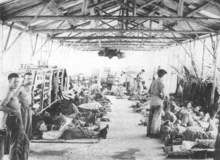Field hospital

Field hospitals ( field stands for the earlier name of the theater of war ) are mobile medical facilities and serve to care for the wounded in a military conflict.
The field hospital follows the rescue station (previously: troop first aid station ) and the rescue center (previously: main first aid station ) as the third link in the military rescue facilities. In conventional warfare, field hospitals are usually far behind the front (older term for it: stage ), between the main dressing station and the war hospital, the standing hospital in the rear of the army area . In the case of occupation operations, however, they are also regularly set up within the conflict areas, which leads to a greatly increased risk to the medical personnel.
Function and equipment
The field hospitals of modern armed forces today have the equipment and capacity of a medium-sized district hospital. In addition to emergency medical and surgical care, intensive medical treatment is also guaranteed. Psychological staff are also available to provide psychological support for the troops. A field hospital has a modular structure and consists of several medical containers in combination with tents, depending on the purpose.
Field hospitals in their current form emerged with the advancement of medicine and were probably first used during the American Civil War. Their forerunners were mobile hospitals of the various knightly orders during the crusades .
The field hospital can if necessary - z. B. due to the changing war situation, for example when the front line is approaching - be relocated as quickly as possible. It is the sphere of activity of the medical service of a military armed force , consisting of medical officers (doctors of all branches of service) and medical personnel. The surgeons in the army were formerly known as field scissors . The military as a field hospital is able to carry out operations and treatments. Depending on the severity of the wound, it is decided whether the operation will be carried out directly on site or in a hospital / military hospital in the home country. Often, however, at a concentration point for the wounded and infected, as is the case in such a hospital, the risk of an outbreak of epidemics is very high. This in turn has an effect on mortality (death rate). In these facilities, therefore, a distinction is made between septic (contagious) and aseptic (non- contagious ) patients in order to minimize this risk.
According to the structure of the armed forces in their units, there are initially several different medical facilities. In the rescue stations and first aid stations, after the wounded have been rescued from the immediate combat area, it is ensured that they are “stabilized” for further transport to the rear medical facilities. Before the rescue, so-called " wounded nests " are usually created in the combat area , which are identified as such by white flags - with or without a red cross.
Special legal status
According to the Geneva Conventions , wound nests marked in this way, as well as ambulance vehicles and their personnel, may not be fired at. Reality often looked and generally looks different. Conversely, because of their special status under the Geneva Convention, medical facilities may not be misused as a “protective shield” for other military units. Ambulance vehicles may not be used for the transfer of troops and the transport of weapons and ammunition. Medical personnel may also not be used in active combat operations. You are not allowed to carry out any security or security tasks. It is still not permitted to house hospitals in the same building as active parts of the armed forces that would be a legitimate target for enemy attacks. Failure by one side to comply with protective measures under international martial law does not release the other warring party from observing its binding rights under international martial law.
See also

Historical sources
- Johann Ulrich Bilguers ... Instructions for practicing Wundarzneykunst in Feldlazarethen . Günther, Leipzig / Glogau 1763 ( digitized edition of the University and State Library Düsseldorf )
Web links
Individual evidence
- ↑ The Volksbrockhaus AZ . 10th edition. Publishing house F. A. Brockhaus / Leipzig, Leipzig C1 Querstraße 16, 1943

